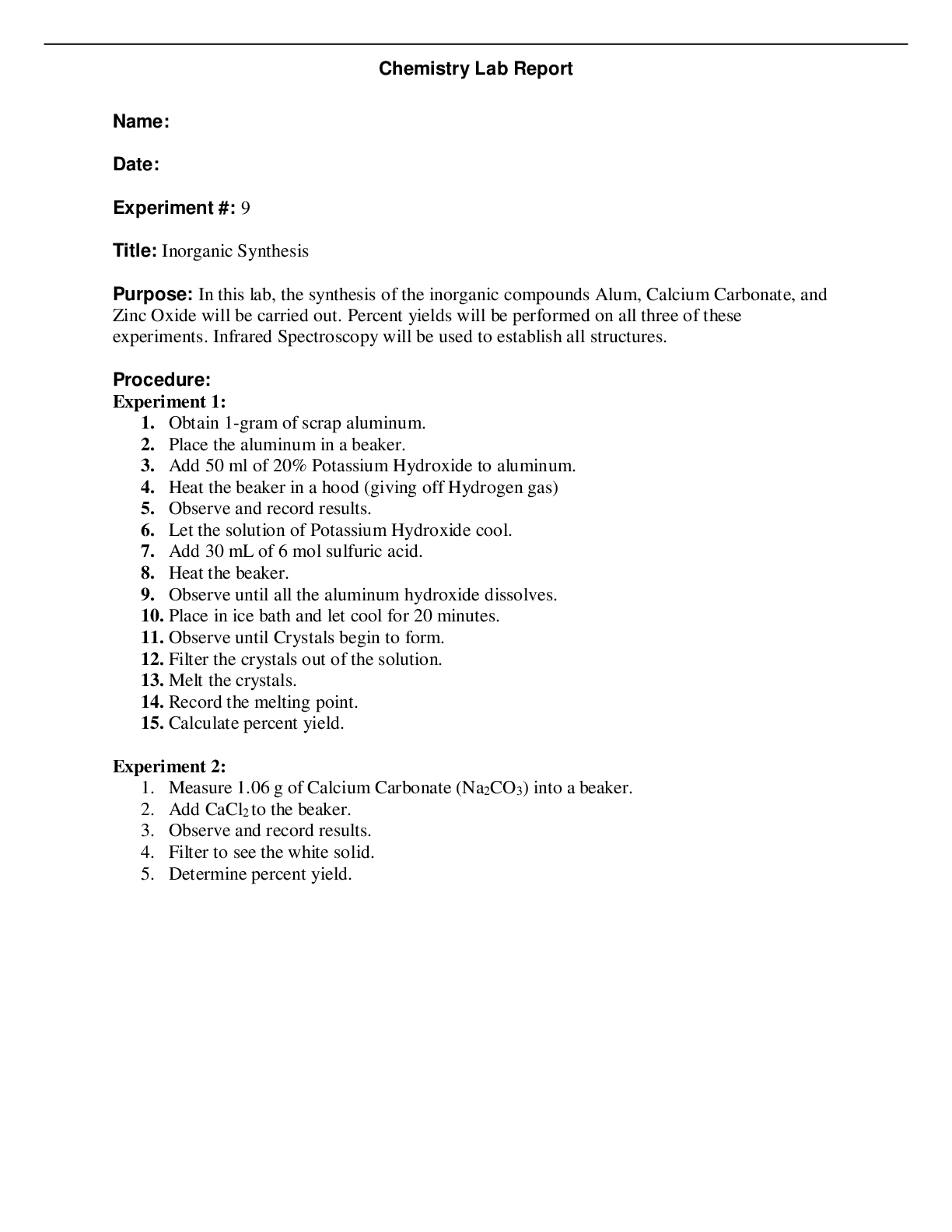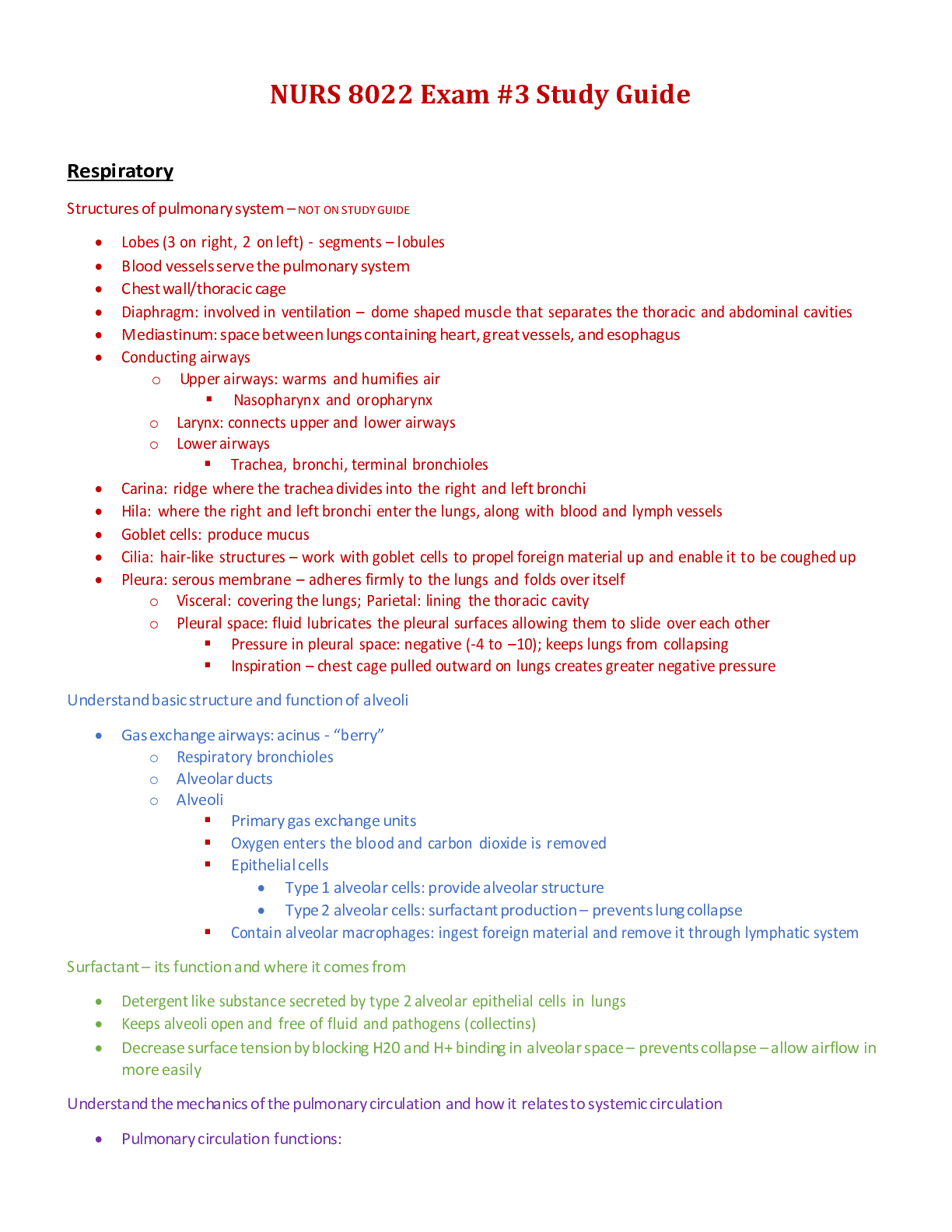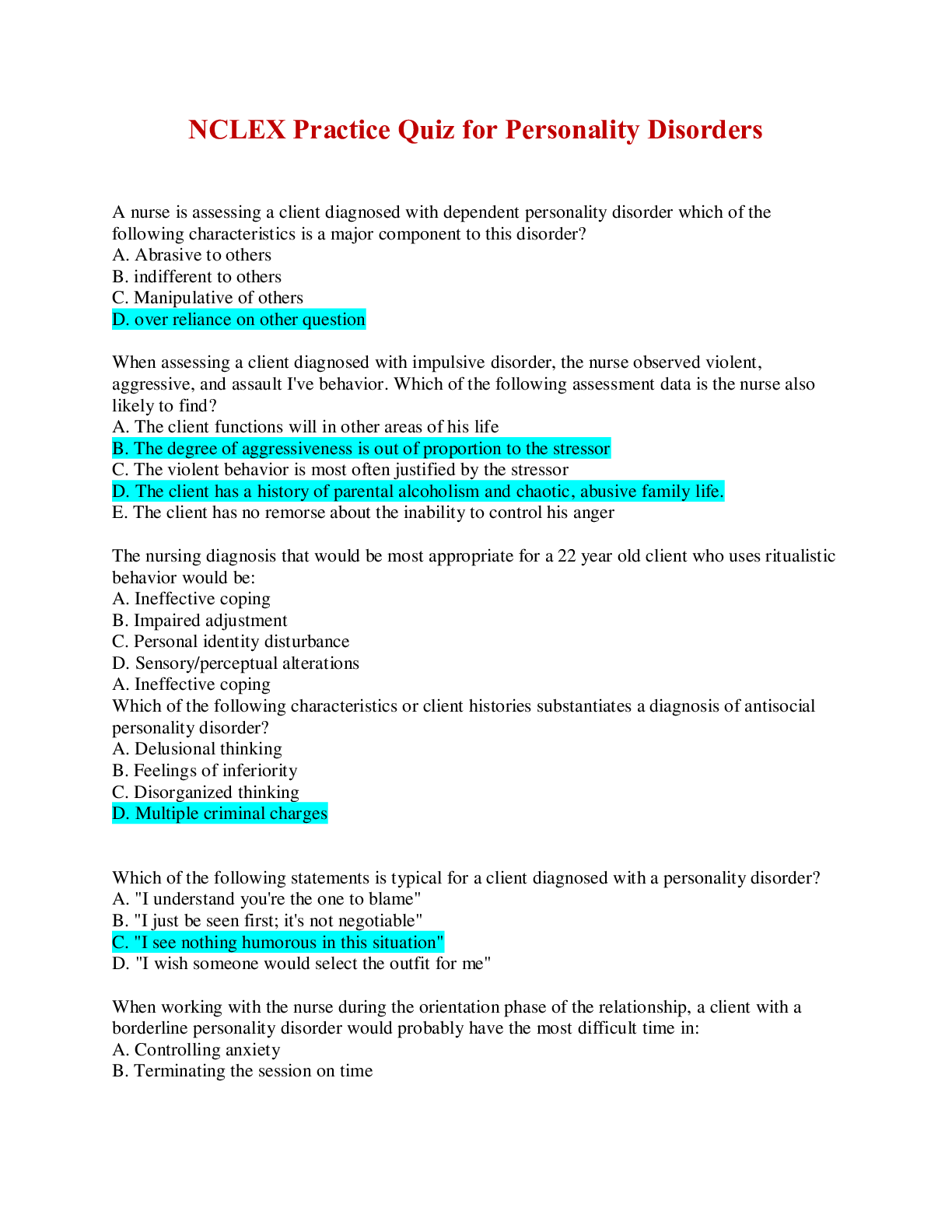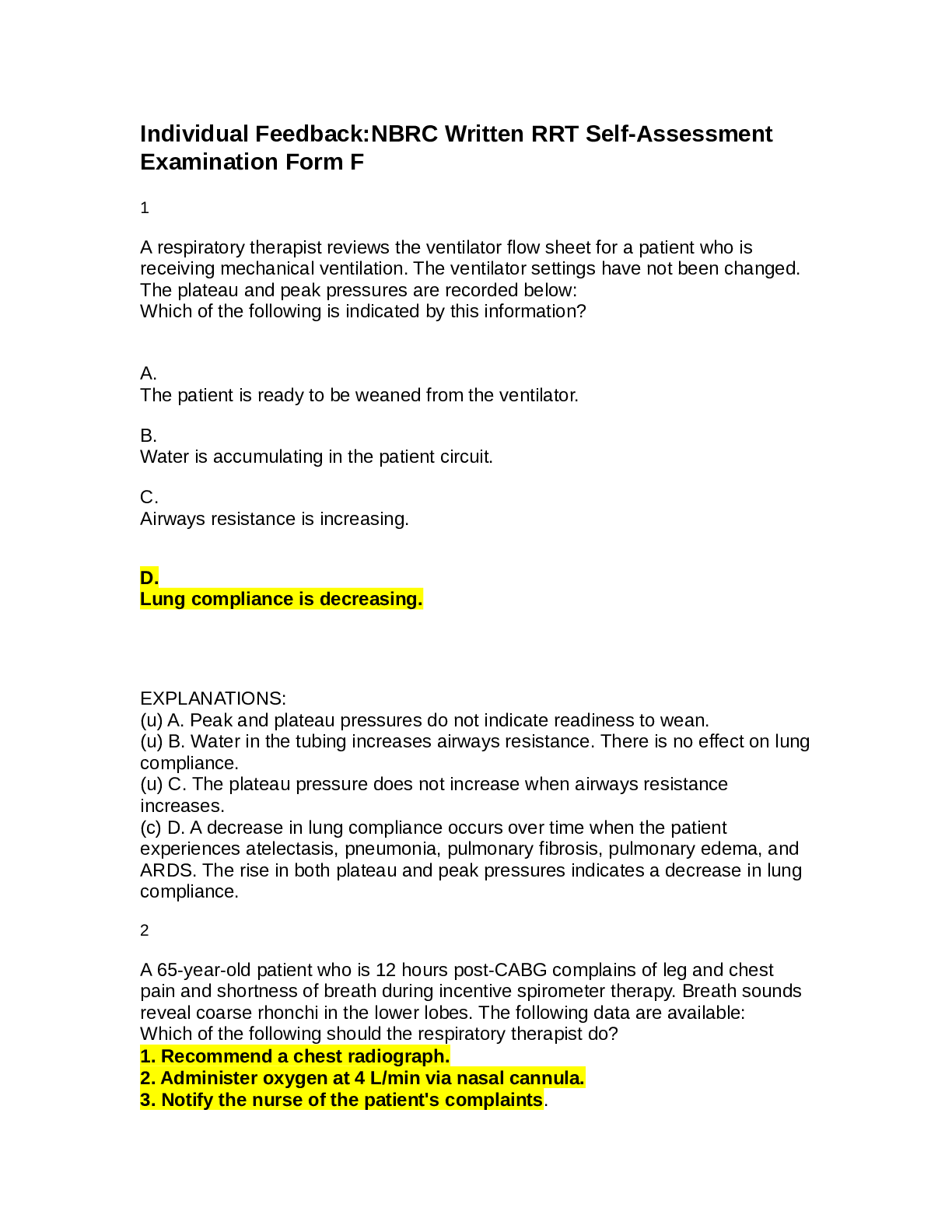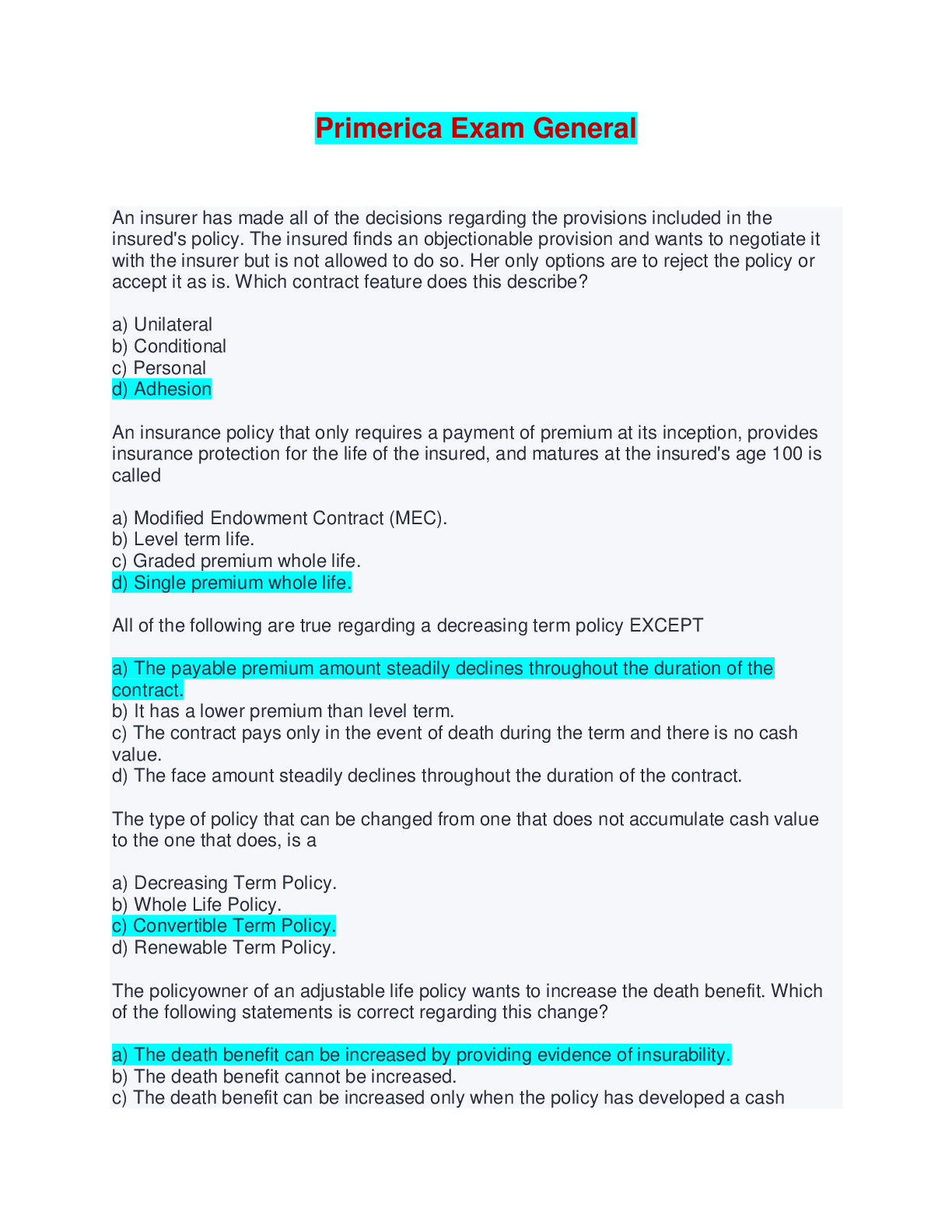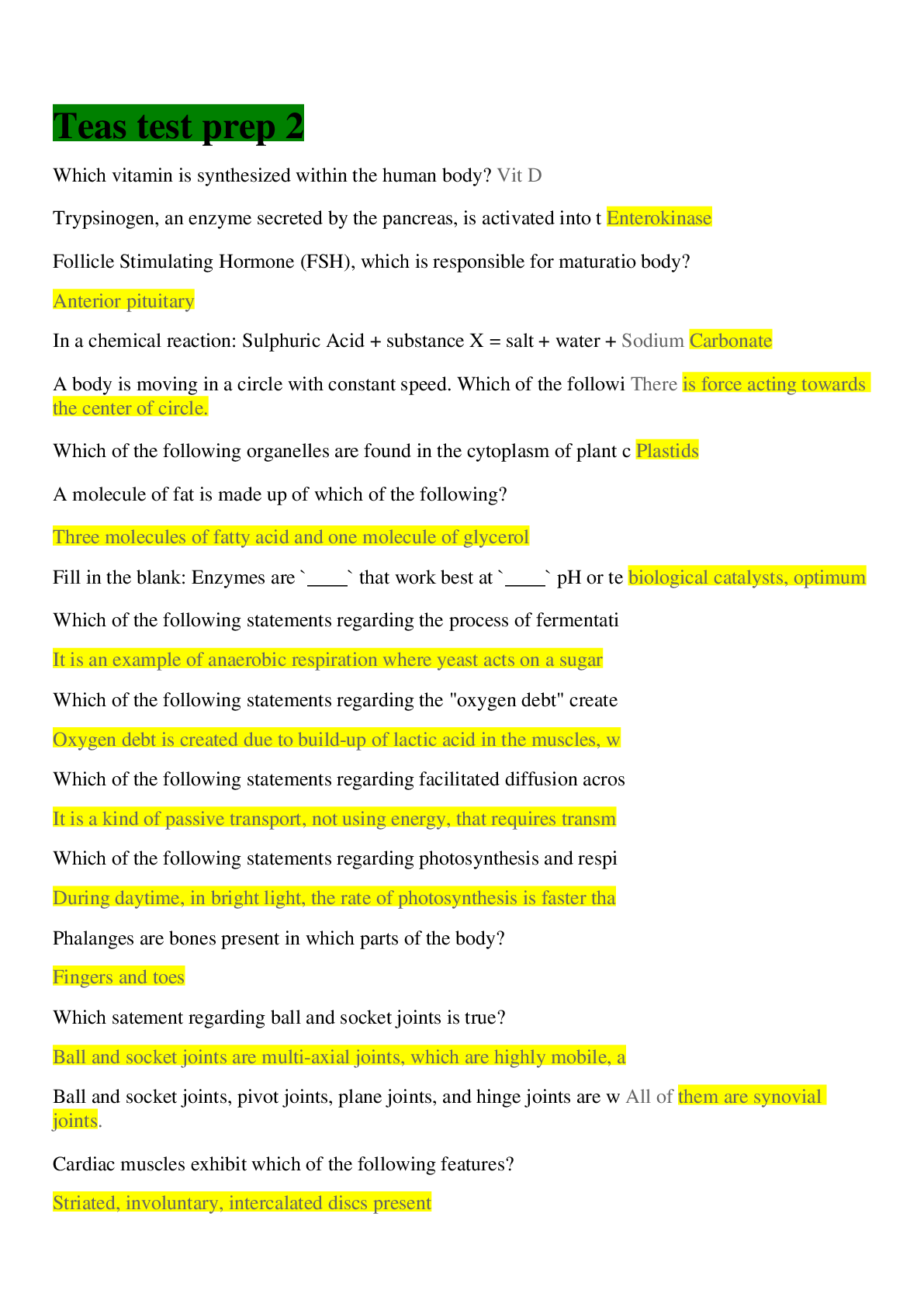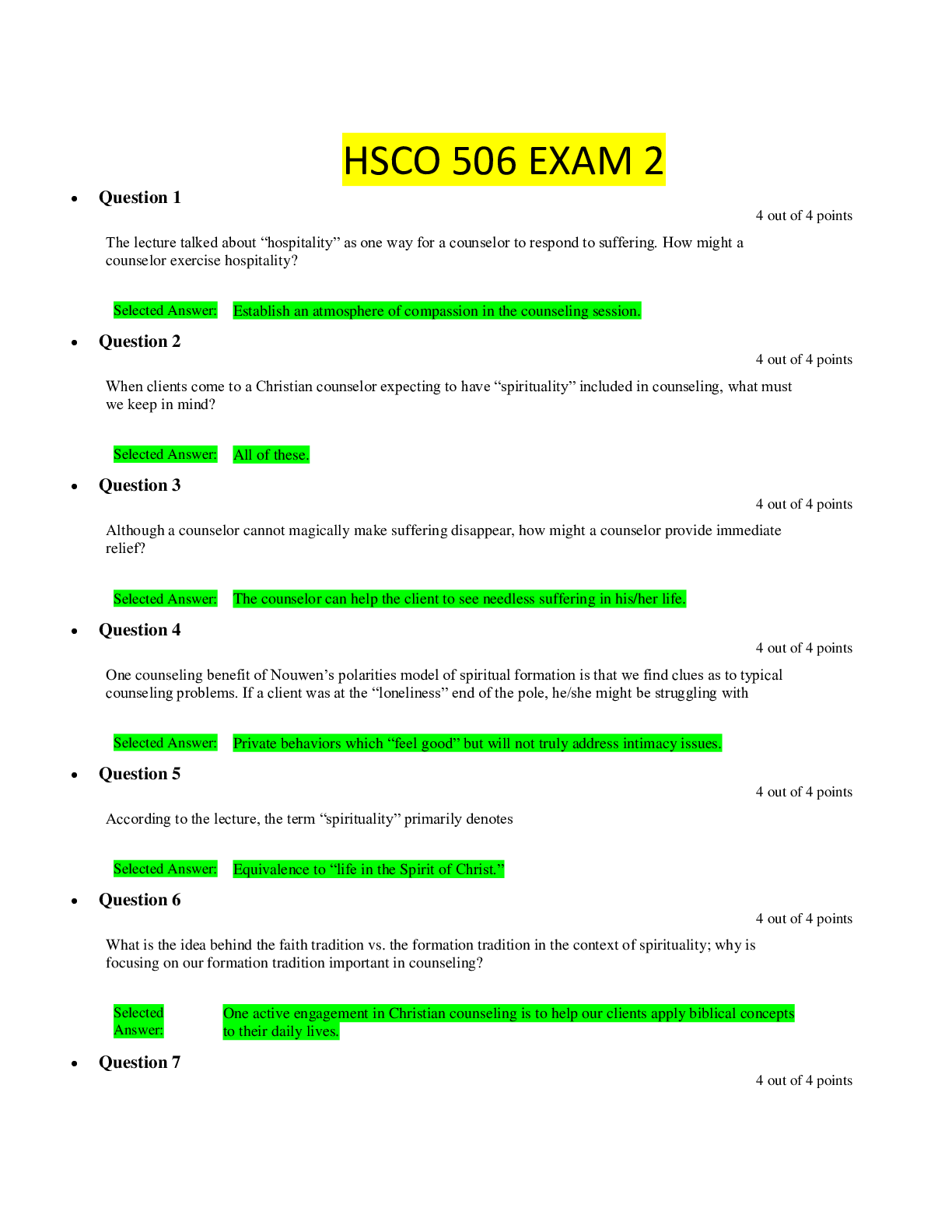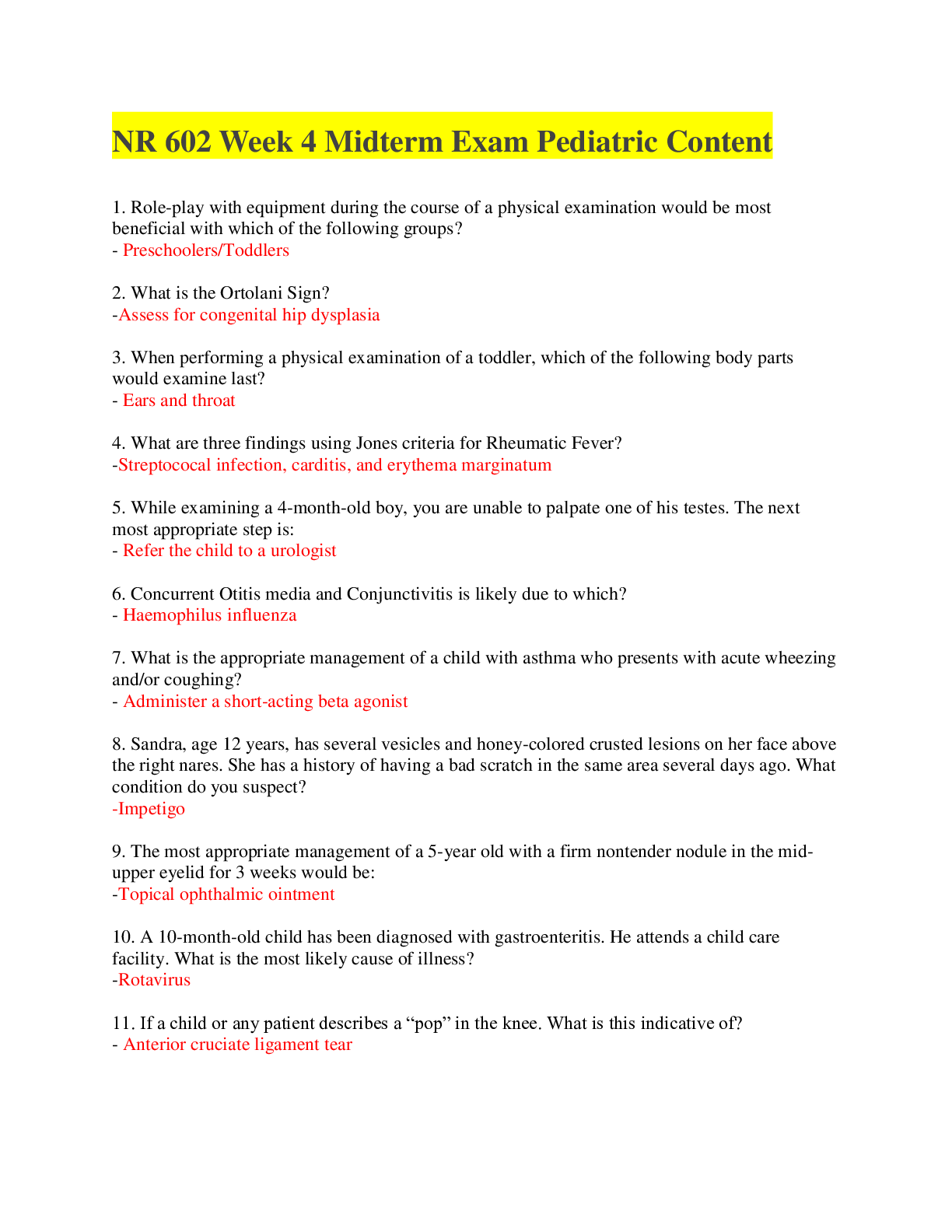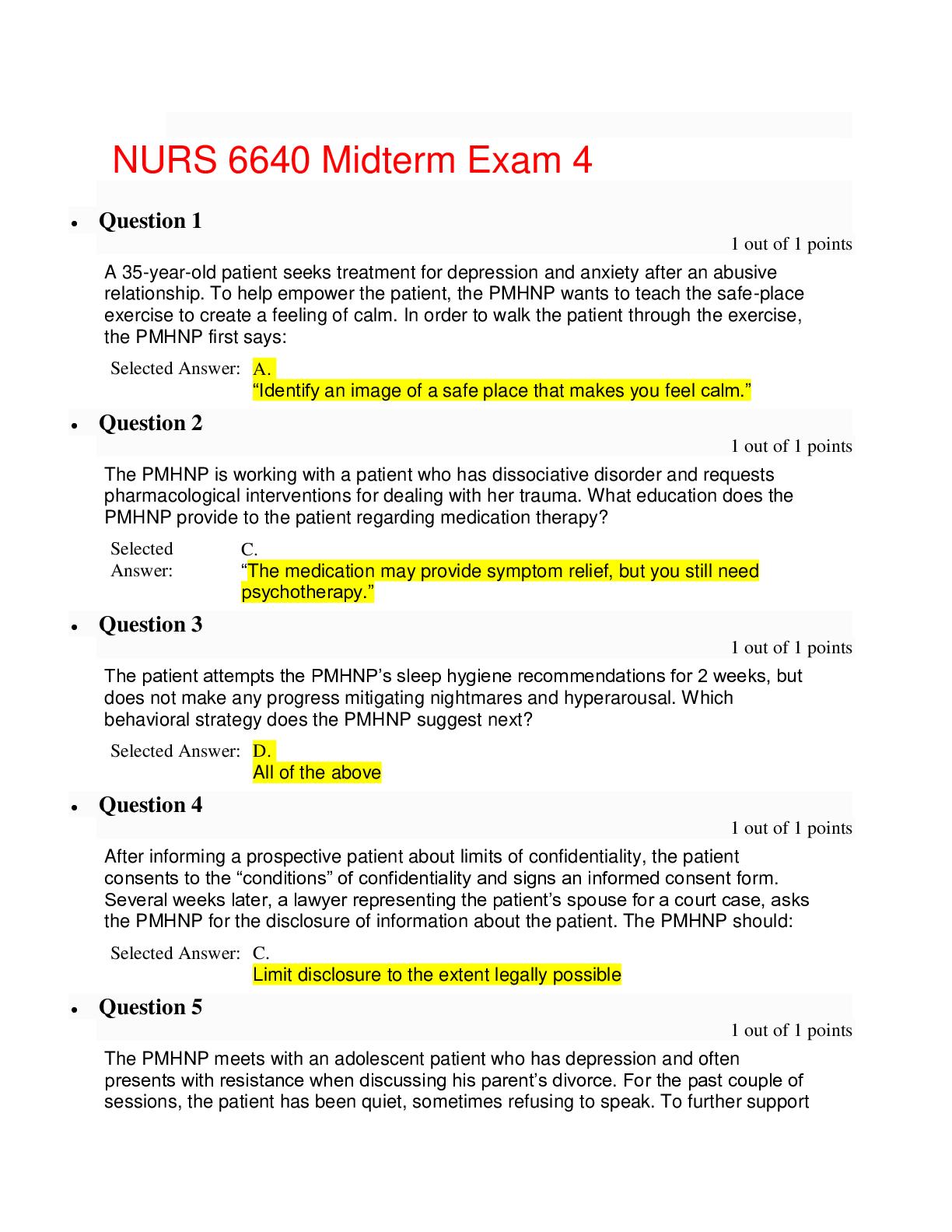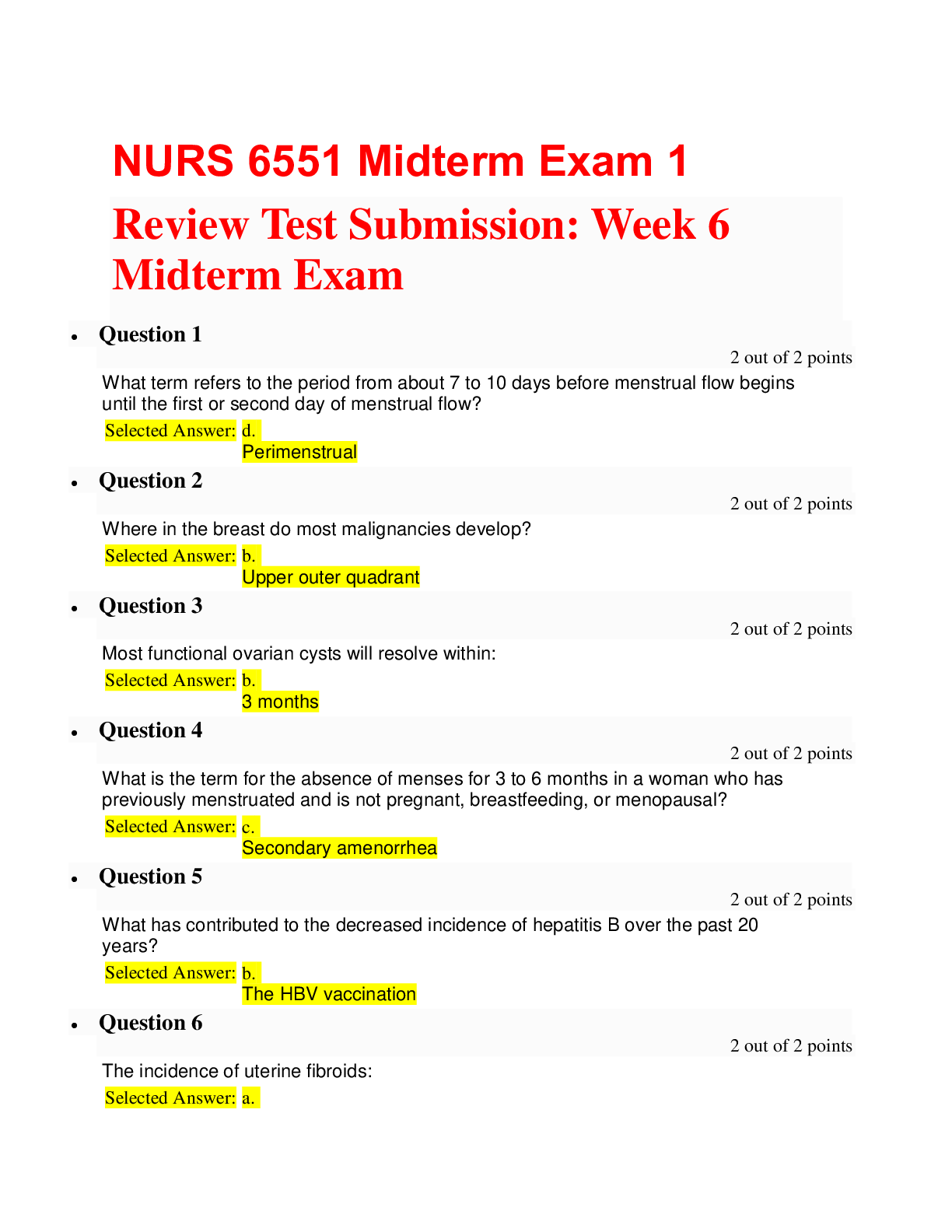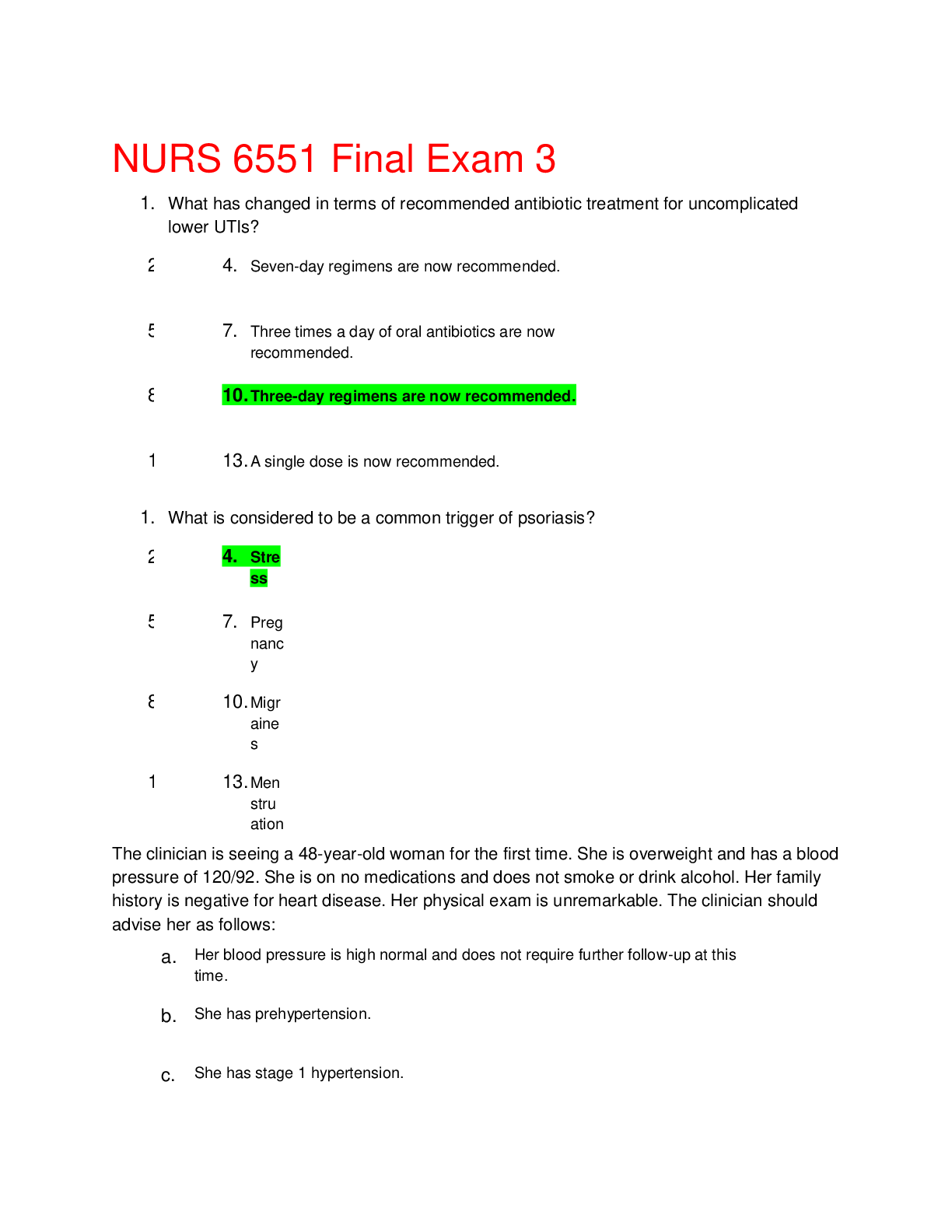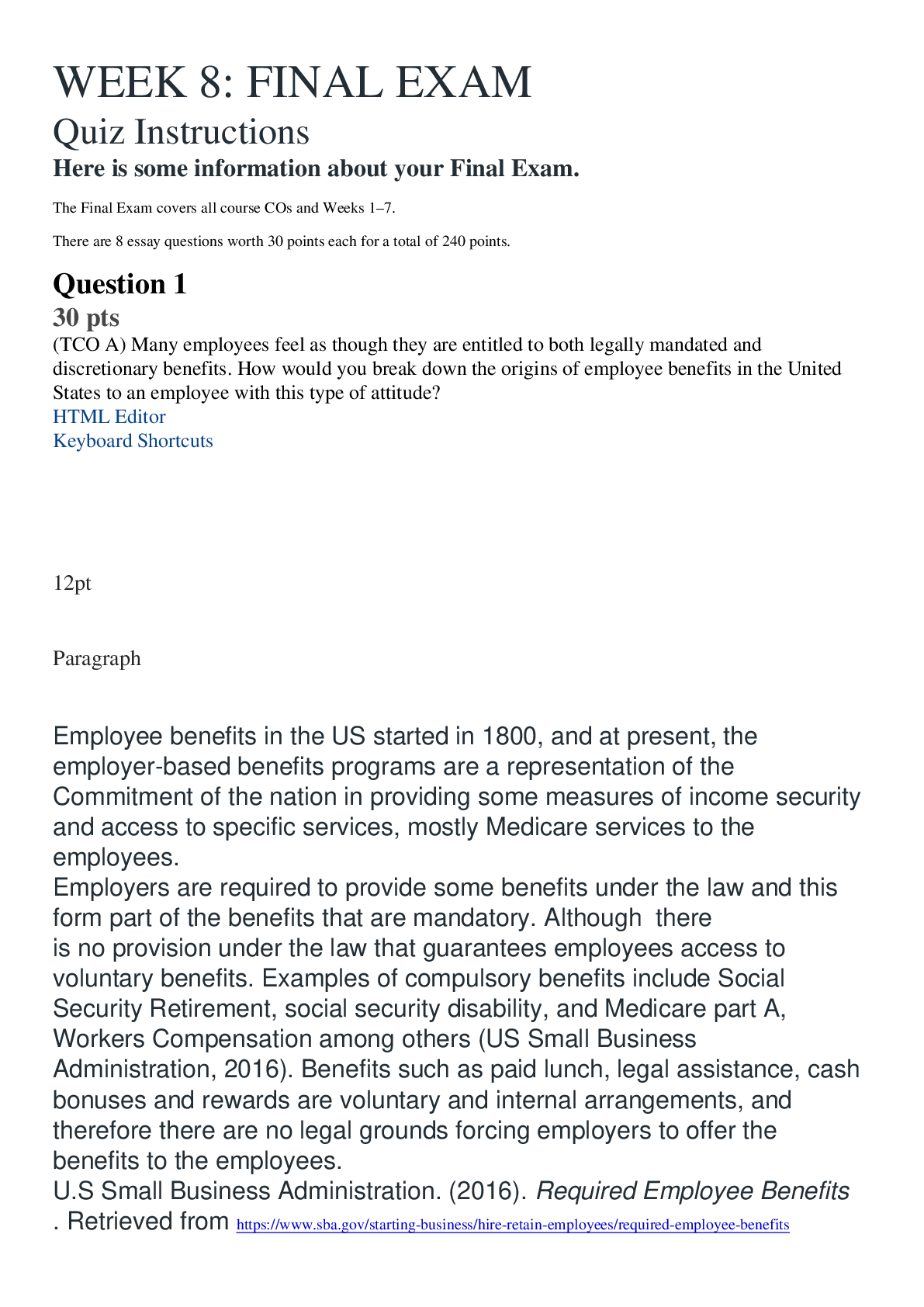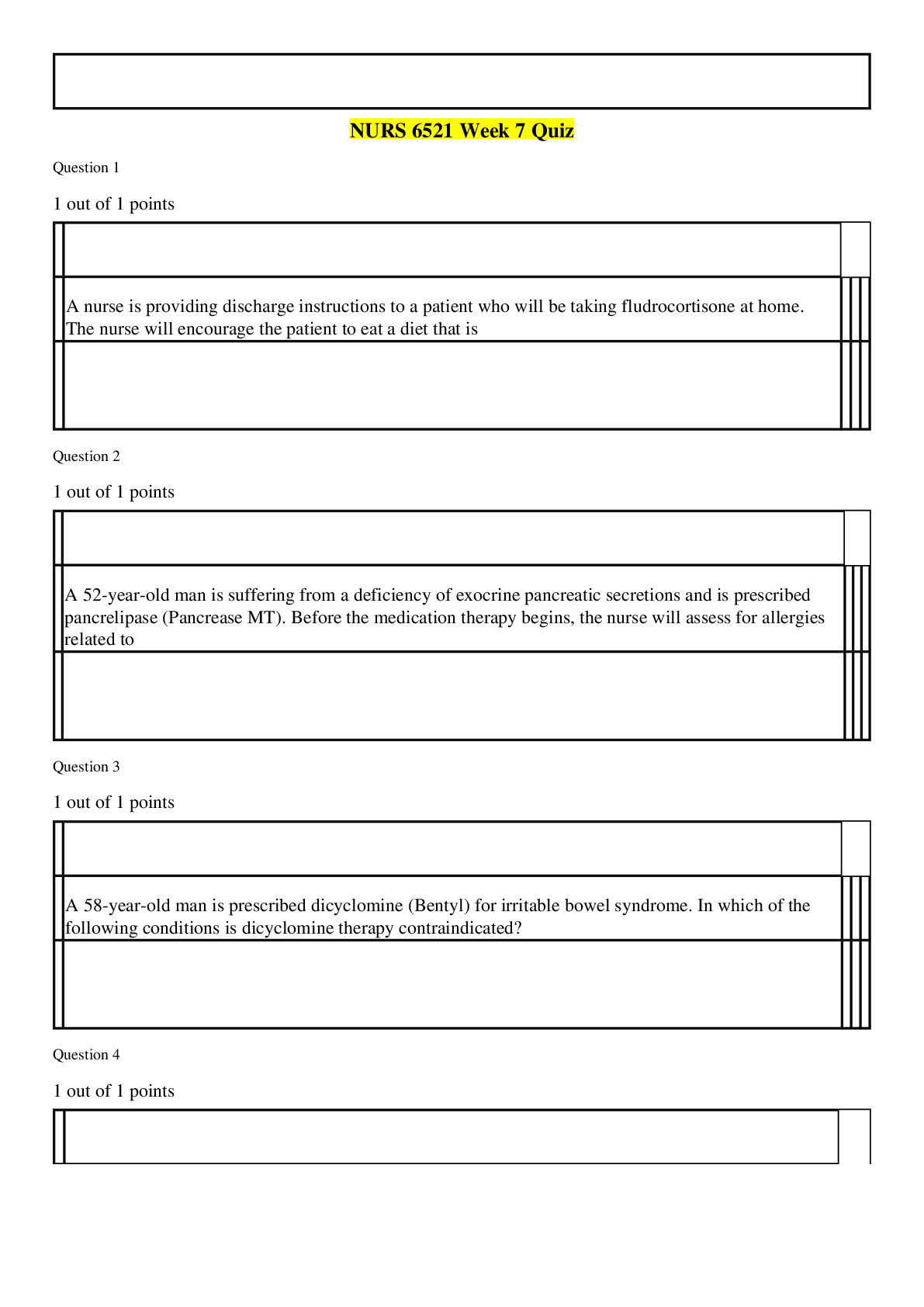ACLS Written Exam - Questions with 100% Correct Answers
Document Content and Description Below
ACLS Written Exam - Questions with 100% Correct Answers You find an unresponsive pt. who is not breathing. After activating the emergency response system, you determine there is no pulse. What is yo... ur next action? Start chest compressions of at least 100 per min. You are evaluating a 58-year-old man with chest pain. The blood pressure is 92/50 mm Hg, the heart rate is 92/min, the nonlabored respiratory rate is 14 breaths/min, and the pulse oximetry reading is 97%. What assessment step is most important now? Obtaining a 12 lead ECG. What is the preferred method of access for epi administration during cardiac arrest in most pts? Peripheral IV An AED does not promptly analyze a rythm. What is your next step? Begin chest compressions. You have completed 2 minutes of CPR. The ECG monitor displays the lead II rhythm below, and the patient has no pulse. Another member of your team resumes chest compressions, and an IV is in place. What management step is your next priority? Administer 1mg of epinephrine During a pause in CPR, you see this lead II ECG rhythm on the monitor. The patient has no pulse. What is the next action? Resume compressions What is a common but sometimes fatal mistake in cardiac arrest management? Prolonged interruptions in chest compressions. Which action is a componant of high-quality chest comressions? Allowing complete chest recoil Which action increases the chance of successful conversion of ventricular fibrillation? Providing quality compressions immediately before a defibrillation attempt. Which situation BEST describes pulseless electrical activity? Sinus rythm without a pulse What is the BEST strategy for performing high-quality CPR on a patient with an advanced airway in place? Provide continuous chest compressions without pauses and 10 ventilations per minute. Three minutes after witnessing a cardiac arrest, one member of your team inserts an endotracheal tube while another performs continuous chest compressions. During subsequent ventilation, you notice the presence of a waveform on the capnography screen and a PETCO2 level of 8 mm Hg. What is the significance of this finding? Chest compressions may not be effective. The use of quantitative capnography in intubated patients allows for monitoring of CPR quality. For the past 25 minutes, an EMS crew has attempted resuscitation of a patient who originally presented in ventricular fibrillation. After the first shock, the ECG screen displayed asystole, which has persisted despite 2 doses of epinephrine, a fluid bolus, and high-quality CPR. What is your next treatment? Consider terminating resuscitive efforts after consulting medical control. Which is a safe and effective practice within the defibrillation sequence? Be sure oxygen is not blowing over the patient's chest during the shock. During your assessment, your patient suddenly loses consciousness. After calling for help and determining that the patient is not breathing, you are unsure whether the patient has a pulse. What is your next action? Begin chest compressions. What is an advantage of using hands-free defibrillation pads instead of defibrillation paddles? Hands-free pads allow for a more rapid defibrillation. What action is recommended to help minimize interruptions in chest compressions during CPR? Continue CPR while charging the defibrillator. Which action is included in the BLS survey? Early defibrillation Which drug and dose are recommended for the management of a patient in refractory ventricular fibrillation? Amioderone 300mg What is the appropriate interval for an interruption in chest compressions? 10 seconds or less Which of the following is a sign of effective CPR? PETCO2 ≥10 mm Hg What is the primary purpose of a medical emergency team (MET) or rapid response team (RRT)? Identifying and treating early clinical deterioration. Which action improves the quality of chest compressions delivered during a resuscitation attempt? Switch providers about every 2 minutes or every 5 compression cycles. What is the appropriate ventilation strategy for an adult in respiratory arrest with a pulse rate of 80/min? 1 breath every 5-6 seconds A patient presents to the emergency department with new onset of dizziness and fatigue. On examination, the patient's heart rate is 35/min, the blood pressure is 70/50 mm Hg, the respiratory rate is 22 breaths/min, and the oxygen saturation is 95%. What is the appropriate first medication? Atropine 0.5mg A patient with dizziness and shortness of breath with a sinus bradycardia of 40/min. The initial atropine dose was ineffective, and your monitor/defibrillator is not equipped with a transcutaneous pacemaker. What is the appropriate dose of dopamine for this patient? 2 to 10 mcg/kg per minute A patient has sudden onset of dizziness. The patient's heart rate is 180/min, blood pressure is 110/70 mm Hg, respiratory rate is 18 breaths/min, and pulse oximetry reading is 98% on room air. The lead II ECG is shown below: Vagal manuever. A monitored patient in the ICU developed a sudden onset of narrow-complex tachycardia at a rate of 220/min. The patient's blood pressure is 128/58 mm Hg, the PETCO2 is 38 mm Hg, and the pulse oximetry reading is 98%. There is vascular access at the left internal jugular vein, and the patient has not been given any vasoactive drugs. A 12-lead ECG confirms a supraventricular tachycardia with no evidence of ischemia or infarction. The heart rate has not responded to vagal maneuvers. What is the next recommended intervention? Adenosine 6mg IV push You are receiving a radio report from an EMS team en route with a patient who may be having an acute stroke. The hospital CT scanner is not working at this time. What should you do in this situation? Divert the patient to a hospital 15 minutes away with CT capabilities. Choose an appropriate indication to stop or withhold resuscitative efforts. Evidence of rigor mortis. A 49-year-old woman arrives in the emergency department with persistent epigastric pain. She had been taking oral antacids for the past 6 hours because she thought she had heartburn. The initial blood pressure is 118/72 mm Hg, the heart rate is 92/min and regular, the nonlabored respiratory rate is 14 breaths/min, and the pulse oximetry reading is 96%. Which is the most appropriate intervention to perform next? Obtain a 12 lead ECG. A patient in respiratory failure becomes apneic but continues to have a strong pulse. The heart rate is dropping rapidly and now shows a sinus bradycardia at a rate of 30/min. What intervention has the highest priority? Simple airway manuevers and assisted ventilations. What is the appropriate procedure for endotracheal tube suctioning after the appropriate catheter is selected? Suction during withdrawal but for no longer than 10 seconds. While treating a patient with dizziness, a blood pressure of 68/30 mm Hg, and cool, clammy skin, you see this lead II ECG rhythm:What is the first intervention ? Atropine 0.5mg A 68-year-old woman experienced a sudden onset of right arm weakness. EMS personnel measure a blood pressure of 140/90 mm Hg, a heart rate of 78/min, a nonlabored respiratory rate of 14 breaths/min, and a pulse oximetry reading of 97%. The lead II ECG displays sinus rhythm. What is the most appropriate action for the EMS team to perform next? Cincinnati Prehospital Stroke Scale assessment EMS is transporting a patient with a positive prehospital stroke assessment. Upon arrival in the emergency department, the initial blood pressure is 138/78 mm Hg, the pulse rate is 80/min, the respiratory rate is 12 breaths/min, and the pulse oximetry reading is 95% on room air. The lead II ECG displays sinus rhythm. The blood glucose level is within normal limits. What intervention should you perform next? Head CT scan What is the proper ventilation rate for a patient in cardiac arrest who has an advanced airway in place? 8-10 breaths per minute A 62-year-old man in the emergency department says that his heart is beating fast. He says he has no chest pain or shortness of breath. The blood pressure is 142/98 mm Hg, the pulse is 200/min, the respiratory rate is 14 breaths/min, and pulse oximetry is 95% on room air. What intervention should you perform next? Obtain a 12 lead ECG. You are evaluating a 48-year-old man with crushing substernal chest pain. The patient is pale, diaphoretic, cool to the touch, and slow to respond to your questions. The blood pressure is 58/32 mm Hg, the heart rate is 190/min, the respiratory rate is 18 breaths/min, and the pulse oximeter is unable to obtain a reading because there is no radial pulse. The lead II ECG displays a regular wide-complex tachycardia. What intervention should you perform next? Synchronized cardioversion What is the initial priority for an unconscious patient with any tachycardia on the monitor? Determine whether pulses are present. Which rhythm requires synchronized cardioversion? Unstable supraventricular tachycardia What is the recommended second dose of adenosine for patients in refractory but stable narrow-complex tachycardia? 12mg What is the usual post-cardiac arrest target range for PETCO2 when ventilating a patient who achieves return of spontaneous circulation (ROSC)? 35-40mm Hg Which condition is a contraindication to therapeutic hypothermia during the post-cardiac arrest period for patients who achieve return of spontaneous circulation ROSC? Responding to verbal commands What is the potential danger of using ties that pass circumferentially around the patient's neck when securing an advanced airway? Obstruction of venous return from the brain [Show More]
Last updated: 1 month ago
Preview 1 out of 17 pages
Instant download
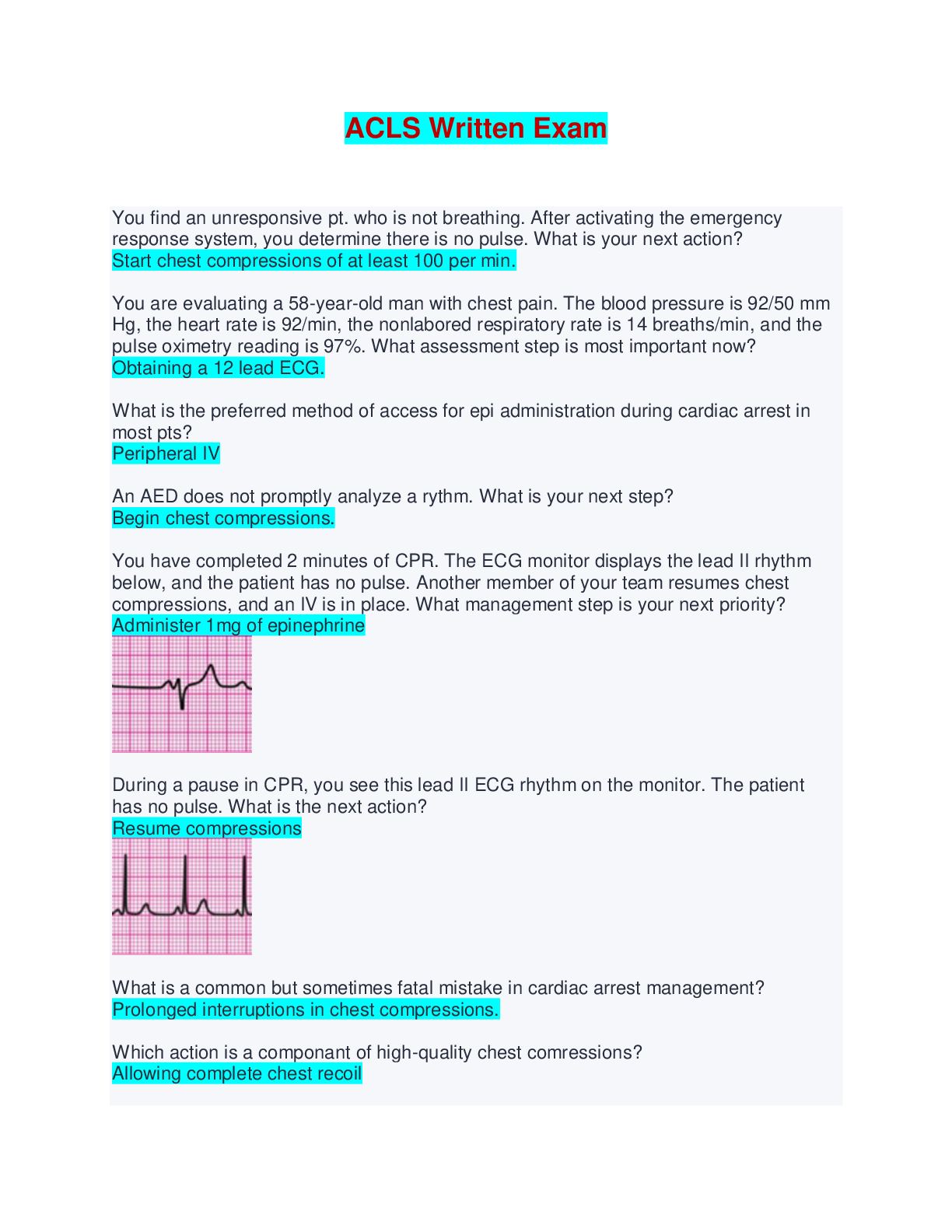
Buy this document to get the full access instantly
Instant Download Access after purchase
Add to cartInstant download
Reviews( 0 )
Document information
Connected school, study & course
About the document
Uploaded On
May 23, 2024
Number of pages
17
Written in
Additional information
This document has been written for:
Uploaded
May 23, 2024
Downloads
0
Views
7



